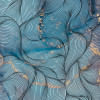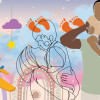Ekushey Boi Mela decor: A blend of old with the new

Boi Mela this year feels to me more lively than in the past year. It fills my heart with joy to see the colourful stalls being adorned with new titles and brimming with readers from all age groups. It is perhaps one of the best arrangements I have seen after the pandemic, and it feels great to see the book fair slowly returning to its previous excitement.
As a visitor, one of the major attractions of the historic book fair is the decorations of the pavilions done by publishers. Be it the use of vibrant shades, taking inspiration from rickshaw art, or relying on the simplicity of monotone, the stalls this year feature a variety of artistic styles and innovative concepts. This not only allows publishers to attract readers by making themselves stand out in a crowd, but also represent the values they promote. Subsequently, publishers put in a lot of effort in designing their spaces, bringing together a fascinating display for visitors.
This year, I spotted some signature designs, including Anyaprokash's pavilion that features Humayun Ahmed—something that they do every year. Located right next to the lake, the pavilion is modelled after a one-storey building, with a life size cutout of the eminent author looking over the fair. Mizan Publishers, on the other hand, continued their legacy of recreating the Curzon Hall. Their pavilion replicated the architectural wonders from the British era that act as a point of interest for the crowds.
Bhashachitro, once again, used recycled materials to decorate their stall. Old manuscripts of published books and their colourful covers create a unique collage on their walls. Having published over 600 books since its inception, the publishers conceptualised this design in order to reduce wastage, given the dire circumstances publishers are going through due to a hike in paper price.
Following a different theme, Ayon Publications highlighted Bangla folklore in their stall design. In an attempt to represent the culture of Bangladesh, the publishers have used several motifs and symbols of national importance. These include cutouts of prominent historical figures like Bangabandhu Sheikh Mujibur Rahman, and Rabindranath Tagore. The vibrant stall also features cutouts of birds, kites, and the iconic Pohela Boishakh face masks. Cultural representation made another special appearance at Akash Prokashoni's pavilion, which has been designed as a bamboo hut and is decorated in classic rural style. Since the publishing house primarily works with history and translation books, they have attempted to create a corner that incorporates their publishing specialty within an innovative design.
Book stalls that replicate bookshelves never fail to amaze me as a reader, and thus Doel Publications' lively pavilion caught my eye. The publishers have used a cutout of their publications' name in creating a space where readers can take the time to browse through books before buying them. Several other stalls, including Chalantika, decorated their stall using a cutout of book spines, making it look like a welcoming bookshelf. This format allows the publishers to display all their books in a limited space.
Nabanna Prokashoni creates a spectacular display of rickshaw art in its stall, providing visitors with a good spot to click pictures while scoring bonus points on cultural representation. The stall also features a rickshaw as a prop, with a dummy sitting on it while reading a book. This corner is always buzzing with readers, clicking pictures with their favourite authors and getting their books autographed.
In the children's corner, there are a number of fascinating stalls, featuring toys, animals, and cartoon characters. One of my favourites was Mayurpankhi's grand purple stall, which was spacious enough to host a number of children at once. The colourful titles placed carefully in shelves, and pillars separating corners makes this stall resemble a library, making young readers feel welcomed.
Maisha Islam Monamee likes reading, scribbling, and blogging. Suggest her new ideas and follow @monameereads on Instagram.

 For all latest news, follow The Daily Star's Google News channel.
For all latest news, follow The Daily Star's Google News channel. 











Comments